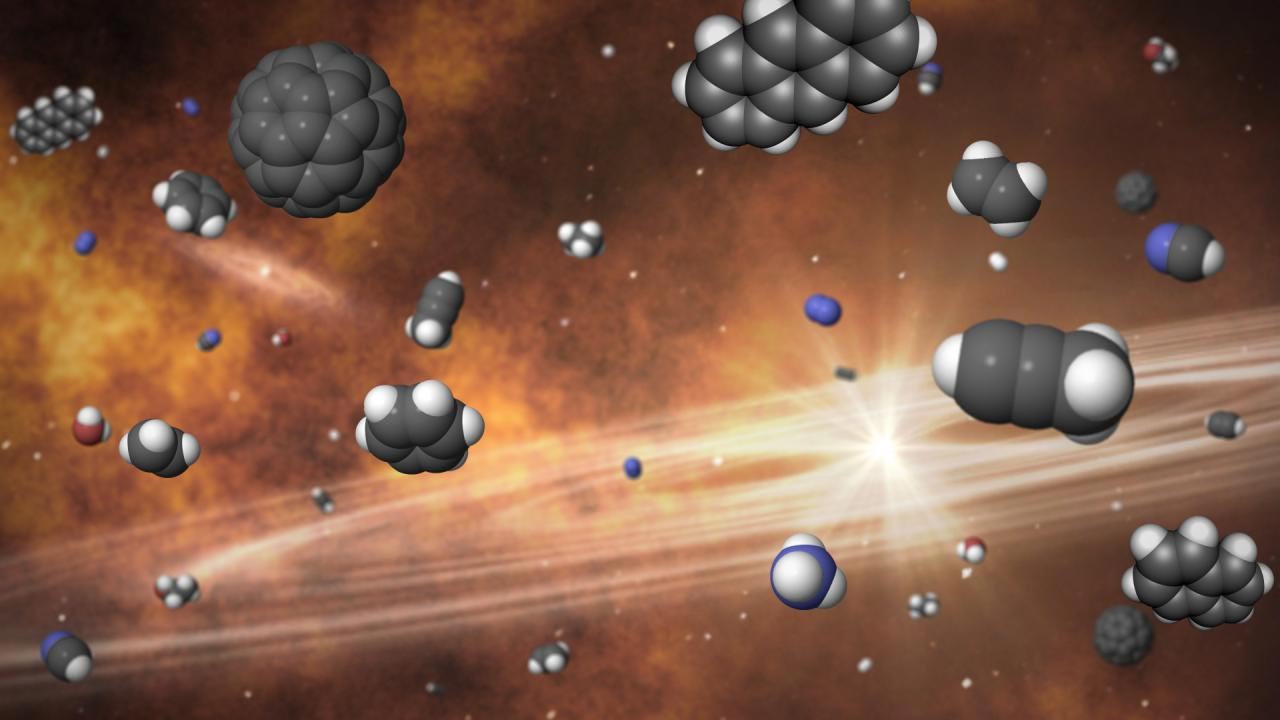原始惑星系円盤の周りのプレバイオティクス粒子の「スープ」のアーティストの構成。 クレジット: Gabriel Perez Diaz (IAC)
カナリア諸島の天文学研究所のスサナ・イグレシアス研究員が行った研究では、太陽系に最も近い星形成領域の 1 つに、複雑な有機分子が大量に存在することが明らかになりました。 その成果が雑誌に掲載されました 王立天文学会の月例通知.
カナリア諸島天文学研究所 (IAC) の科学者 Suzanne Iglesias-Groth とカルタヘナ工科大学の Martina Marin-Dobrenic は、周囲の若い星団であるペルセウス分子雲の星形成領域 IC348 でいくつかのプレバイオティクス分子を発見しました。約200~300万年前の時代。
これらの生体分子の一部は、次のようなより複雑な分子を構築するための基本的なビルディング ブロックです。[{” attribute=””>amino acids, which formed the genetic code of ancient micro-organisms, and brought about the flourishing of life on Earth. Getting to know the distribution and the abundances of these precursor molecules in regions where planets are very probably forming, is an important challenge for astrophysics.
The Perseus Cloud is one of the star-forming regions closest to the Solar System. Many of its stars are young, and have protoplanetary discs where the physical processes which give rise to planets can take place. “It is an extraordinary laboratory of organic chemistry” explains Iglesias-Groth who in 2019 found fullerenes in the same cloud. These are complex molecules of pure carbon that often occur as building blocks for the key molecules of life.
Now new research has detected in the inner part of this region common molecules such as molecular hydrogen (H2), hydroxyl (OH), water (H2O), carbon dioxide (CO2) and ammonia (NH3) as well as several carbon-bearing molecules which could play an important role in the production of more complex hydrocarbons and prebiotic molecules, such as hydrogen cyanide (HCN), acetylene (C2H2), diacetylene (C4H2), cyanoacetylene (HC3N), cyanobutadiyne (HC5N), ethane (C2H6), hexatriyne (C6H2) and benzene (C6H6).
The data also show the presence of more complex molecules such as the polycyclic aromatic hydrocarbons (PAH) and the fullerenes C60 and C70. “IC 348 seems to be very rich and diverse in its molecular content” states Iglesias-Gorth. “The novelty is that we see the molecules in the diffuse gas from which stars and protoplanetary discs are forming.”
The presence of prebiotic molecules at interstellar sites so close to star clusters suggests the possibility that accretion processes are taking place on young planets which could contribute to the formation of complex organic molecules. These key molecules could have been supplied to the nascent planets in the protoplanetary discs and could in this way help to produce there a route towards the molecules of life” stresses Marina-Dobrincic.
The detection by the two researchers is based on data taken with NASA’s Spitzer satellite. The next step will be to use the powerful James Webb Space Telescope (JWST). “The spectroscopic capacity of the JWST could provide details about the spatial distribution of all these molecules, and extend the present search to others which are more complex, giving higher sensitivity and resolution which are essential to confirm the very probable presence of amino acids in the gas in this and in other star-forming regions” concludes Iglesias-Groth.
Reference: “A rich molecular chemistry in the gas of the IC 348 star cluster of the Perseus Molecular Cloud” by Susana Iglesias-Groth and Martina Marin-Dobrincic, 16 March 2023, Monthly Notices of the Royal Astronomical Society.
DOI: 10.1093/mnras/stad495

「音楽マニア。プロの問題解決者。読者。受賞歴のあるテレビ忍者。」



More Stories
JGB Curveは、日本の金融の健康に関する懸念の中で認めています – TradingViewニュース
週末の睡眠を補うことで心臓病のリスクが5分の1減少する可能性がある――研究 |心臓病
化石によると、先史時代のカイギュウはワニとサメに食べられた